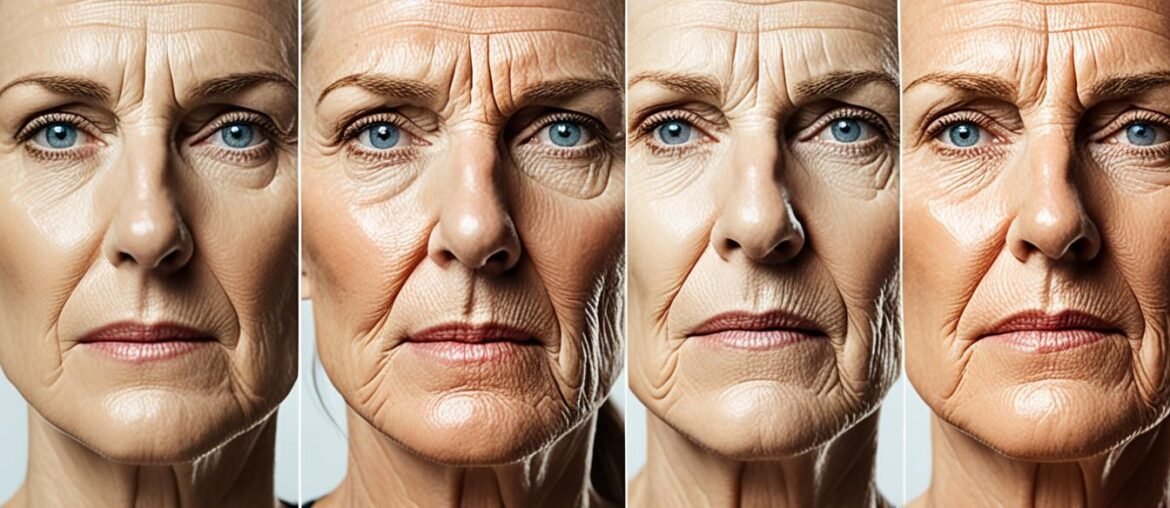Did you know that stress can accelerate the aging process of your skin? Yes, it’s true! According to recent studies, stress-related skin aging is a common concern for many individuals, and its effects can be significant. Factors like oxidative stress and reduced antioxidant protection can lead to premature aging, wrinkles, and dullness, leaving your skin vulnerable to damage.
In the pursuit of maintaining youthful and healthy-looking skin, it’s important to understand the role of antioxidants. These powerful natural compounds have been shown to combat oxidative stress and protect your skin from the harmful effects of environmental factors, helping you achieve a radiant and more youthful appearance.
Key Takeaways:
- Stress can accelerate the aging process of the skin, leading to premature wrinkles and dullness.
- Oxidative stress, caused by factors like pollution and UV radiation, contributes to stress-related skin aging.
- Antioxidants are crucial in combating oxidative stress and protecting the skin from damage.
- By incorporating antioxidant-rich skincare products and a healthy lifestyle, you can prevent and minimize the effects of stress-related skin aging.
- Stay tuned to learn more about specific mechanisms and strategies for preserving your skin health and preventing stress-related skin aging!
The Role of Melanin in DNA Protection
Research by Nielsen et al. has shown that melanin, a pigment found in the skin, plays a crucial role in protecting DNA and other photobiological processes. Melanin is responsible for the color of our skin, hair, and eyes and acts as a natural sunscreen by absorbing and scattering harmful ultraviolet (UV) radiation from the sun.
When UV radiation penetrates the skin, it can lead to the formation of reactive oxygen species (ROS), causing oxidative damage to DNA. However, melanin acts as a shield, absorbing UV radiation and preventing it from reaching the deeper layers of the skin where DNA is located.
In addition to its protective role, melanin also has antioxidant properties. It can neutralize ROS and minimize the damage they cause to DNA and other cellular components. This antioxidant effect helps to maintain the integrity of the DNA and prevents mutations that can lead to various skin disorders and premature aging.
“Melanin serves as a natural defense mechanism against the harmful effects of UV radiation, providing DNA protection and preserving skin health.”
Understanding the role of melanin in DNA protection is crucial for developing effective strategies to combat stress-related skin aging. By promoting the production of melanin and enhancing its distribution throughout the skin, we can enhance its protective effects and reduce the risk of DNA damage caused by oxidative stress.
Furthermore, incorporating antioxidants into skincare products can provide an additional layer of protection against oxidative stress. Antioxidants help to neutralize ROS and prevent their harmful effects on DNA and other cellular components.
Benefits of Melanin in DNA Protection:
- Reduces the risk of DNA damage caused by UV radiation
- Preserves skin health and prevents premature aging
- Enhances the skin’s natural defense mechanisms against oxidative stress
- Minimizes the risk of mutations and skin disorders
By harnessing the power of melanin and incorporating it into our skincare routines, we can ensure better DNA protection and maintain healthier, more youthful-looking skin.
The Barrier Function of the Stratum Corneum
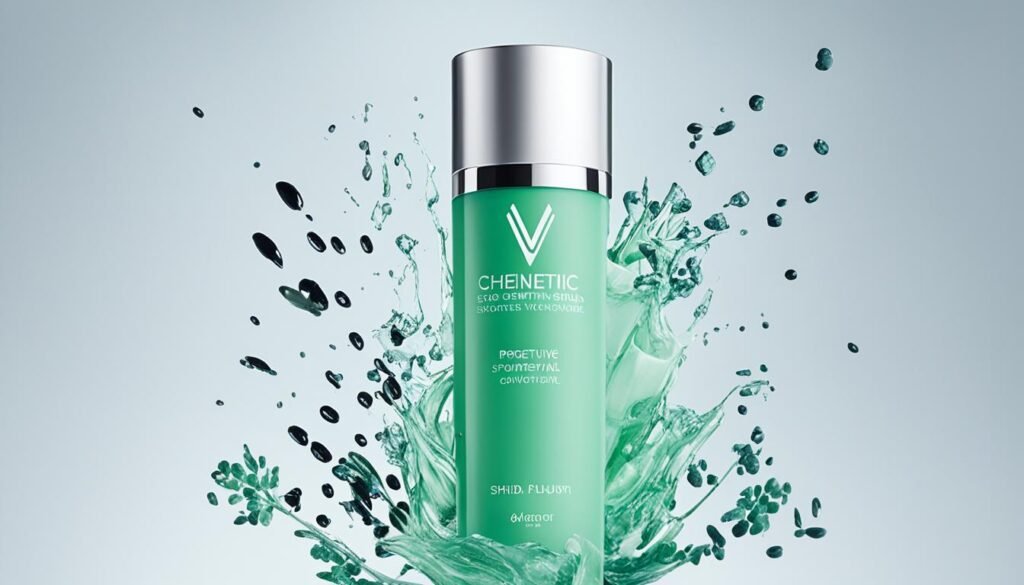
The stratum corneum is a crucial component of the skin’s barrier function. It plays a vital role in protecting the underlying skin layers from external stressors such as pollutants, chemicals, and UV radiation.
The stratum corneum is the outermost layer of the epidermis, composed of dead skin cells called corneocytes embedded in a lipid matrix. This unique structure acts as a defense mechanism, preventing unwanted substances from penetrating the skin and maintaining optimal hydration levels.
The barrier function of the stratum corneum is essential for preventing stress-related skin aging. When this protective layer becomes compromised, the skin becomes more susceptible to damage and premature aging.
Image:
Research conducted by Matsui and Amagai sheds light on the formation, structure, and physiological importance of the stratum corneum. Their findings emphasize the role of ceramides, cholesterol, and fatty acids in maintaining the integrity of the lipid matrix and preserving the barrier function.
A well-functioning stratum corneum not only prevents the entry of harmful substances but also retains the skin’s natural moisture, preventing excessive dryness and dehydration. This, in turn, helps maintain the skin’s elasticity, suppleness, and overall health.
Maintaining the integrity of the stratum corneum is essential for preventing stress-related skin aging and preserving overall skin health.
The Importance of Skin Structure
The stratum corneum’s barrier function is closely intertwined with the overall structure of the skin. Properly understanding the skin’s anatomy and physiology is crucial for developing effective skincare strategies.
Table:
| Component | Description |
|---|---|
| Epidermis | The outermost layer of the skin responsible for providing waterproof protection |
| Dermis | The middle layer containing collagen, elastin, and blood vessels, contributing to the skin’s strength and elasticity |
| Hypodermis | The innermost layer composed of fat cells that provide insulation and serve as energy storage |
Understanding the complex interplay between these layers and their individual components, such as collagen, elastin, and hyaluronic acid, is crucial for maintaining skin health and preventing aging.
The combination of a well-functioning stratum corneum and a healthy skin structure is essential for effective skin aging prevention. Implementing skincare routines that support and strengthen the skin’s natural barrier function can significantly contribute to the overall health and vitality of the skin.
The Role of Autophagy in Skin Aging
Autophagy, a cellular process involved in the removal of damaged or dysfunctional components, plays a crucial role in skin aging. Studies conducted by Eckhart et al. highlight the importance of autophagic control in maintaining skin health and preventing the effects of stress-related skin aging. Autophagy acts as a protective mechanism by eliminating harmful substances and promoting cellular rejuvenation.
Autophagy is particularly vital in counteracting the damaging effects of oxidative stress on the skin. Oxidative stress occurs when there is an imbalance between the production of reactive oxygen species (ROS) and the skin’s antioxidant defenses. This imbalance leads to the accumulation of damaged proteins and organelles, contributing to skin aging.
The process of autophagy helps remove these damaged components, preventing their build-up and promoting cellular renewal. By clearing out dysfunctional cells and recycling cellular waste, autophagy helps maintain the health and longevity of skin cells.
Furthermore, autophagy plays a role in regulating inflammation and immune responses in the skin. Chronic inflammation and impaired immune function can accelerate skin aging processes. Autophagy helps modulate these processes, keeping the skin’s immune system in balance and reducing the harmful effects of inflammation.
Autophagy and Skin Aging Research
“Autophagy represents a fundamental cellular mechanism for the maintenance of skin health and prevention of stress-related skin aging.” – Eckhart et al.
The interplay between autophagy and oxidative stress is a dynamic area of research. The understanding of the signaling pathways and molecular mechanisms involved in autophagy provides potential targets for developing effective anti-aging strategies.
| Study | Findings |
|---|---|
| Eckhart et al. (2016) | Highlighted the importance of autophagic control in maintaining skin health and preventing stress-related skin aging. |
| Fimia et al. (2019) | Investigated the role of autophagy in regulating skin inflammation and immune responses. |
| Pellon-Maison et al. (2018) | Explored the cross-talk between autophagy and other cellular processes involved in skin aging, such as cellular senescence. |
Understanding the cellular mechanisms underlying autophagy and its role in maintaining skin health holds great promise for developing innovative anti-aging interventions. Further research is needed to unravel the complexities of autophagy and its interactions with various factors influencing skin aging.
The Turnover Time of Epidermal Cells
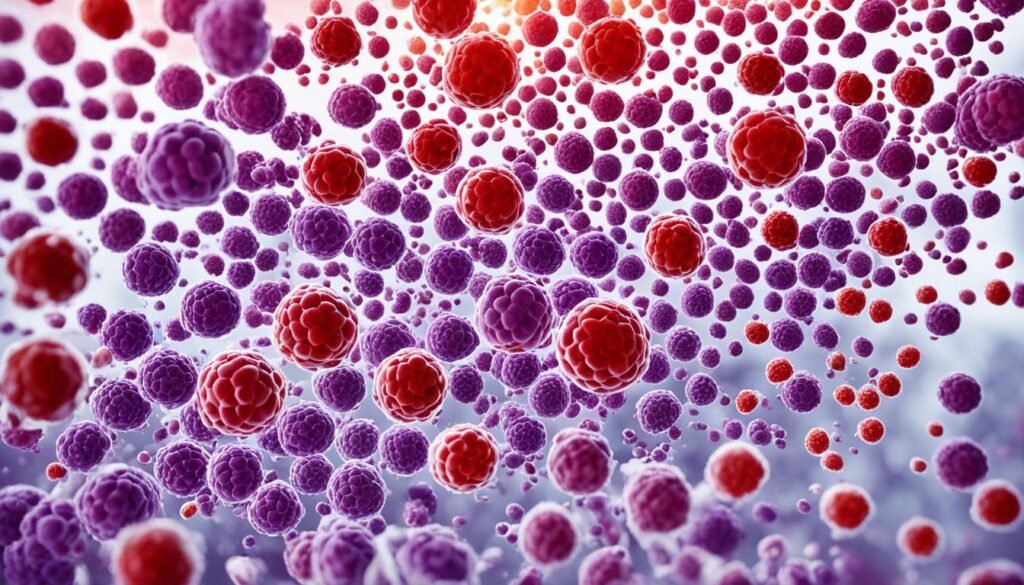
The turnover time of epidermal cells plays a crucial role in maintaining the health and vitality of the skin. Epidermal cells are constantly regenerating and renewing, ensuring that the outermost layer of the skin remains fresh and youthful. Understanding the dynamics of epidermal cell turnover is essential for preventing and treating stress-related skin aging.
Research conducted by Halprin challenges the conventional understanding of epidermal turnover time, highlighting the need for further investigation. By unraveling the intricacies of this process, scientists can gain valuable insights into the cellular mechanisms that contribute to skin regeneration and overall skin health.
Epidermal cell turnover refers to the process of old skin cells being shed and replaced by new ones. This turnover time varies among individuals, influenced by factors such as age, genetics, and environmental stressors. By studying the turnover time of epidermal cells, researchers can identify potential interventions that can enhance the skin’s regenerative capacity.
The Importance of Epidermal Cell Turnover
The turnover time of epidermal cells is closely linked to the skin’s ability to repair and rejuvenate itself. As we age, the turnover time tends to slow down, leading to the accumulation of old and damaged cells on the skin’s surface. This accumulation can contribute to a dull complexion, uneven texture, and the appearance of fine lines and wrinkles.
Encouraging a faster turnover time can help to prevent these signs of aging, as the skin continuously sheds old cells and replaces them with fresh ones. This process promotes a smoother and more youthful appearance, as well as improved overall skin health.
“Understanding the turnover time of epidermal cells provides valuable insights into the prevention and treatment of stress-related skin aging.”
The Role of Skin Regeneration
Epidermal cell turnover is closely linked to skin regeneration. The continuous renewal of skin cells ensures that the skin can repair itself from damage caused by external stressors such as UV radiation and pollution. By studying the turnover time of epidermal cells, researchers can gain a deeper understanding of the mechanisms underlying skin regeneration and explore strategies to enhance this process.
Enhancing skin regeneration can have a significant impact on stress-related skin aging. By optimizing the turnover time of epidermal cells, the skin can better resist the damaging effects of stress, leading to a healthier, more resilient complexion.
The Importance of Further Investigation
While much research has been conducted on epidermal cell turnover, there is still a need for further investigation. Halprin’s research highlights the complexity of this process and raises questions that require in-depth exploration. By delving deeper into the intricacies of epidermal cell turnover, scientists can unlock new insights and develop innovative approaches to prevent and treat stress-related skin aging.
Investigating the turnover time of epidermal cells is crucial for advancing our understanding of skin aging and regeneration. Through continued research and exploration, we can uncover novel strategies to promote optimal skin health and combat the effects of stress-related skin aging.
P16INK4a Positive Cells and Skin Aging
The presence of P16INK4a positive cells in human skin has been found to be closely associated with various aspects of skin aging, including elastic fiber morphology, facial wrinkling, and perceived age. Research conducted by Waaijer et al. sheds light on the significance of P16INK4a positive cells and their impact on skin health and aging.
The protein P16INK4a, also known as p16, is a tumor suppressor that plays a pivotal role in regulating cell cycle progression and cellular senescence. Overexpression of P16INK4a has been observed in various aging-related conditions, including stress-related skin aging.
Studies have shown that the accumulation of P16INK4a positive cells in the skin is associated with decreased regenerative capacity, impaired collagen synthesis, and altered extracellular matrix remodeling. These cellular changes contribute to the visible signs of skin aging, such as reduced elasticity, increased wrinkling, and loss of overall skin firmness.
Table: Effects of P16INK4a Positive Cells on Skin Aging
| Aspects of Skin Aging | Association with P16INK4a Positive Cells |
|---|---|
| Elastic Fiber Morphology | Altered elastic fiber morphology and decreased elasticity |
| Facial Wrinkling | Increased facial wrinkling and fine lines |
| Perceived Age | Higher perceived age due to visible signs of skin aging |
| Regenerative Capacity | Reduced regenerative capacity and delayed wound healing |
| Collagen Synthesis | Impaired collagen synthesis and decreased skin firmness |
Understanding the mechanisms underlying the development and function of P16INK4a positive cells is crucial for developing targeted interventions to combat stress-related skin aging. Further research aims to explore strategies to modulate the accumulation and activity of these cells, potentially reversing or attenuating the signs and symptoms of skin aging.
The Development of Melanocytes
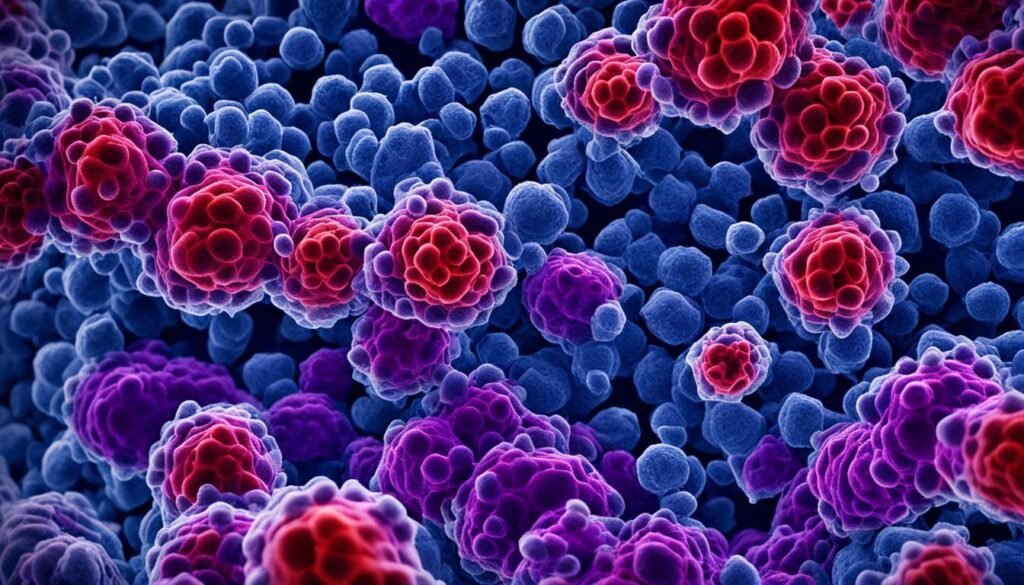
In the study conducted by Cichorek et al., the focus was on the biology and development of skin melanocytes. Melanocytes play a crucial role in skin development and contribute to various processes, including pigmentation and wound healing.
Melanocyte stem cells have been a subject of interest in recent research, as they hold great therapeutic potential for skin disorders. Studies by Birlea et al. and Lee et al. have explored the potential of using melanocyte stem cells in repigmentation treatments for disorders such as vitiligo and stress-related skin aging.
Exploring the regenerative potential of melanocytes opens up new possibilities for combating stress-related skin aging and other related conditions. By understanding the intricate mechanisms involved in the development and function of melanocytes, researchers can develop targeted interventions that promote optimal skin health and repigmentation.
Advancements in Melanocyte Research
One significant advancement in the field of melanocyte research is the discovery of specific markers that enable the identification and isolation of melanocyte stem cells. Researchers have identified surface markers such as CD117, CD34, and Nestin, which aid in the isolation and characterization of melanocyte stem cells.
Furthermore, studies have shown that the microenvironment, or niche, surrounding melanocyte stem cells plays a crucial role in regulating their behavior and function. Understanding the interactions between melanocyte stem cells and their niche can provide valuable insights into harnessing their regenerative potential for therapeutic purposes.
“The regenerative potential of melanocytes offers promise for developing innovative treatments for various skin disorders, including stress-related skin aging and vitiligo.”
Melanocyte Development in Skin
| Stage of Development | Description |
|---|---|
| Embryonic stage | Melanoblasts migrate from the neural crest to the epidermis, where they differentiate into melanocytes. |
| Postnatal stage | Melanocytes proliferate and disperse throughout the epidermis, contributing to pigmentation. |
| Adult stage | Melanocyte populations become relatively stable, with ongoing turnover and regulation of pigmentation. |
The table above illustrates the different stages of melanocyte development in the skin. From the embryonic stage to the adult stage, melanocytes undergo intricate processes that contribute to the overall function and appearance of the skin.
Note: The table is for illustrative purposes only and does not represent actual quantitative data.
The image above visually represents the intricate development of melanocytes in the skin. Melanocytes are responsible for producing the pigment melanin, which gives color to the skin and protects it from the damaging effects of ultraviolet (UV) radiation.
Understanding the development and function of melanocytes provides valuable insights into skin development, repigmentation therapies, and combating stress-related skin aging.
The Regenerative Potential of Skin and the Immune System
In recent research conducted by Tsepkolenko et al., valuable insights have been gained into the regenerative potential of the skin, as well as its interactions with the immune system. This groundbreaking study highlights the integral role that the immune system plays in the process of skin regeneration, paving the way for the development of innovative and effective anti-aging strategies.
It is well-established that the skin possesses remarkable regenerative capabilities, enabling it to repair and rejuvenate itself over time. However, the intricate relationship between skin health, immune function, and stress-related skin aging necessitates further investigation to fully comprehend the complex interplay at play.
The immune system, equipped with its diverse array of cells and signaling molecules, acts as the body’s defense system against pathogens and harmful foreign substances. This system also plays a crucial role in the regulation and maintenance of tissue homeostasis.
When it comes to skin regeneration, the immune system is not merely a bystander. It actively participates in the process, orchestrating a complex interplay of cellular and molecular events that facilitate tissue repair and renewal. The immune cells, such as macrophages and T cells, regulate inflammation and promote wound healing in the skin.
The regenerative potential of the skin and its interaction with the immune system hold immense promise for combating the effects of aging, particularly stress-related skin aging. By understanding the mechanisms underlying skin regeneration and the role of the immune system, researchers can develop targeted interventions to counteract the signs of aging and enhance overall skin health.
The Anti-Aging Effects of Skin Regeneration
When the regenerative potential of the skin is harnessed effectively, it can have profound anti-aging effects. The rejuvenation and renewal of skin cells can lead to improvements in skin texture, tone, and elasticity. Additionally, enhanced skin barrier function and increased collagen production contribute to a more youthful and radiant complexion.
Moreover, studies have shown that skin regeneration has the potential to counteract the visible signs of aging, such as fine lines, wrinkles, and age spots. By stimulating the production of new cells and promoting the turnover of damaged ones, the regenerative process can help restore a more youthful appearance.
It is important to note that the regenerative potential of the skin diminishes with age. Therefore, uncovering the intricate relationship between the immune system and skin regeneration is crucial for developing targeted interventions and therapies that can counteract the effects of aging and promote long-lasting skin health.
| Regenerative Potential of Skin | Immune System | Anti-Aging Effects |
|---|---|---|
| Repair and rejuvenation of the skin | Active participation in the process of skin regeneration | Improvements in skin texture, tone, and elasticity |
| Enhanced skin barrier function | Regulation of inflammation and wound healing | Reduction in fine lines, wrinkles, and age spots |
| Increased collagen production | Promotion of tissue repair and renewal | Restoration of a more youthful appearance |
While significant progress has been made in uncovering the regenerative potential of the skin and its intricate relationship with the immune system, there is still much to learn. Further research and exploration are needed to deepen our understanding of this complex interplay and develop evidence-based strategies to harness the regenerative power of the skin for anti-aging purposes.
The Role of Growth Factors in Skin Health
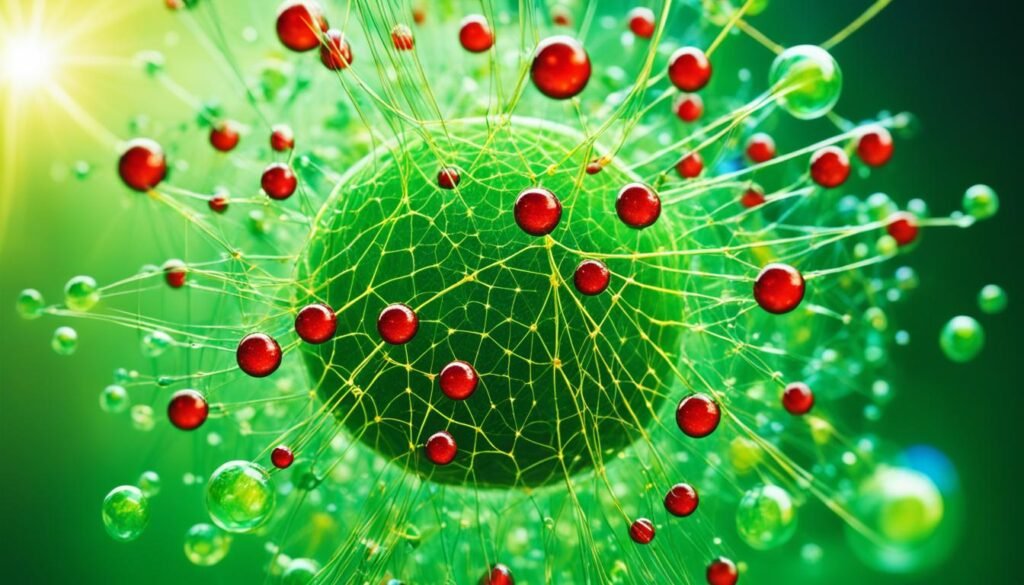
Growth factors play a crucial role in maintaining and promoting skin health. They are signaling molecules that regulate various cellular processes involved in skin regeneration and repair. Research conducted by Taipale and Keski-Oja has shed light on the significance of growth factors in skin health and the extracellular matrix.
The extracellular matrix (ECM) is a complex network of proteins, glycoproteins, and polysaccharides that provides structural support to the skin. It also plays a vital role in cell signaling and tissue homeostasis. The interaction between growth factors and the extracellular matrix is essential for proper skin wound healing and anti-aging interventions.
“Understanding the mechanisms underlying growth factor signaling can provide valuable insights into preventing and treating stress-related skin aging.”
The extracellular matrix serves as a reservoir for growth factors, controlling their availability and activity within the skin. The binding of growth factors to the ECM influences their signaling pathways and regulates cellular processes such as migration, proliferation, and differentiation.
De Laporte et al. have emphasized the importance of the extracellular matrix in growth factor-mediated skin regeneration. Their research highlights the potential of engineered biomaterials that mimic the ECM to enhance the delivery and efficacy of growth factors for tissue repair and anti-aging interventions.
Growth Factors and Skin Regeneration
The effects of growth factors on skin regeneration have been investigated extensively. Growth factors such as epidermal growth factor (EGF), transforming growth factor-beta (TGF-β), and fibroblast growth factors (FGFs) have been shown to stimulate cell proliferation, collagen synthesis, and angiogenesis, promoting wound healing and tissue regeneration.
Moreover, growth factors are involved in regulating the migration and differentiation of stem cells, which play a critical role in replenishing and repairing damaged skin tissue. By modulating the behavior of stem cells, growth factors contribute to the regeneration of healthy skin cells and the restoration of skin structure and function.
The interaction between growth factors, the extracellular matrix, and stem cells is a complex process that requires further exploration. Understanding the intricate mechanisms involved in growth factor signaling can pave the way for innovative approaches to prevent and treat stress-related skin aging.
| Growth Factors | Functions |
|---|---|
| Epidermal growth factor (EGF) | Promotes cell proliferation and wound healing |
| Transforming growth factor-beta (TGF-β) | Stimulates collagen synthesis and regulates inflammation |
| Fibroblast growth factors (FGFs) | Induces angiogenesis and tissue repair |
“The interaction between growth factors and the extracellular matrix is essential for proper skin wound healing and anti-aging interventions.”
The discoveries made by Taipale, Keski-Oja, and De Laporte have broadened our understanding of the role of growth factors in skin health and regeneration. The intricate interplay between growth factors and the extracellular matrix holds tremendous potential for developing innovative therapeutic strategies to prevent and treat stress-related skin aging.
Age-Related Changes in the Extracellular Matrix
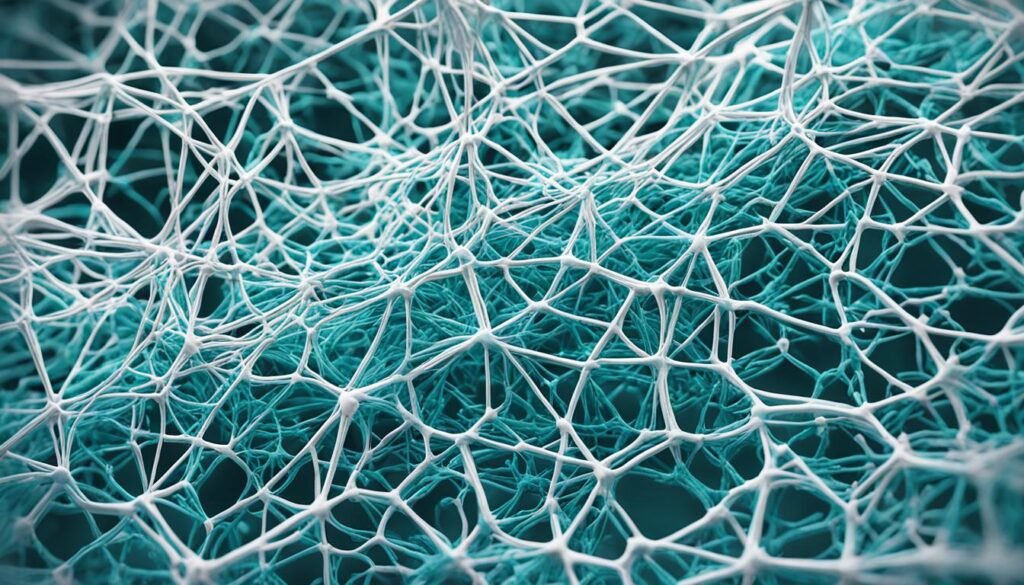
Aging is a natural process that affects various aspects of our bodies, including the skin. One important factor in skin aging is the extracellular matrix, which undergoes changes over time. Studies conducted by Lynch and Pei have shed light on these age-related alterations and their impact on skin health.
The extracellular matrix provides structural support to the skin and plays a crucial role in maintaining its elasticity and integrity. It consists of proteins, such as collagen and elastin, as well as glycosaminoglycans and proteoglycans. With age, there is a gradual loss of these components, leading to a decline in skin firmness and elasticity.
Moreover, the extracellular matrix also plays a role in maintaining stem cell function, which is essential for the regeneration and renewal of the skin. Research conducted by Kurtz and Oh has highlighted the interplay between the extracellular matrix and stem cells, emphasizing their importance in skin aging and regenerative medicine.
Stem cells are responsible for replenishing and repairing damaged tissues, including the skin. However, with age, the maintenance and function of stem cells become compromised. The extracellular matrix provides a supportive environment for stem cells, promoting their survival and proper functioning. Understanding the interactions between the extracellular matrix and stem cells is crucial for developing strategies to maintain stem cell maintenance and delay the onset of skin aging.
The Role of Oxidative Stress
Oxidative stress, caused by an imbalance between the production of reactive oxygen species and the body’s antioxidant defenses, is a contributing factor to age-related changes in the extracellular matrix. It leads to the degradation of collagen and elastin, impairing the structural integrity of the skin.
Furthermore, oxidative stress can also affect the function of stem cells, leading to their premature senescence and decreased regenerative capacity. The extracellular matrix acts as a protective barrier against oxidative stress by providing antioxidant molecules and enzymes. However, with age, the ability of the extracellular matrix to neutralize reactive oxygen species diminishes, exacerbating the effects of oxidative stress on the skin.
Understanding the complex relationship between the extracellular matrix, skin aging, and stem cell maintenance is crucial for developing effective interventions to prevent stress-related skin aging. By targeting the extracellular matrix and oxidative stress, it may be possible to delay the signs of aging and promote skin health.
Elastin Structure and Its Involvement in Skin Photoaging
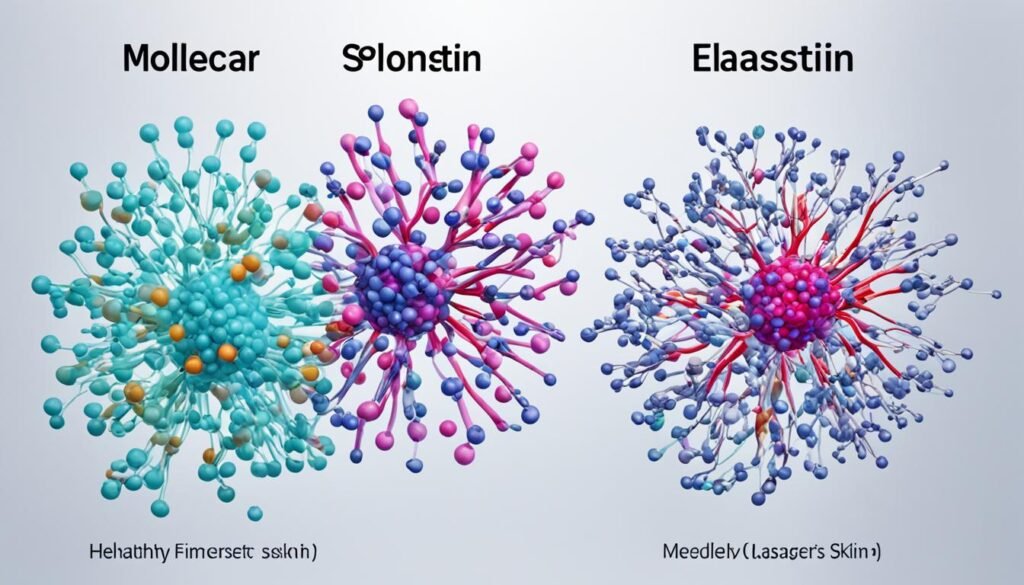
Elastin, a key component of the skin’s extracellular matrix, undergoes age-associated changes that contribute to skin photoaging. These changes in the structure and function of elastin are influenced by various environmental stressors, as highlighted in research by Weihermann et al. and Guerrero-Juarez and Plikus.
The structural alterations of elastin during skin photoaging not only impact the elasticity and resilience of the skin but also play a role in the development of wrinkles, sagging, and loss of firmness. These age-associated changes in elastin can be attributed to the cumulative effects of ultraviolet (UV) radiation, pollution, and other external factors.
Understanding the specific mechanisms by which elastin is affected by these stressors is of significant importance in comprehending the pathogenesis of stress-related skin aging. The research by Weihermann et al. delves into the intricate biochemical processes that contribute to the degradation and remodeling of elastin fibers. Similarly, Guerrero-Juarez and Plikus explore the dynamic interactions between immune cells, hair follicles, and the extracellular matrix, shedding light on the role of elastin in skin homeostasis and regeneration.
By unraveling the mechanisms that govern elastin structure and its involvement in skin photoaging, researchers can pave the way for the development of targeted anti-aging interventions. These interventions can aim to restore the functionality and integrity of elastin, ultimately rejuvenating the skin and mitigating the visible signs of stress-related skin aging.
Elastin Remodeling and Skin Aging
Elastin remodeling, a complex process influenced by various extracellular matrix components and enzymes, plays a critical role in skin aging. The dysregulation and degradation of elastin can result in the loss of skin elasticity, leading to the formation of fine lines, wrinkles, and sagging.
A deeper understanding of the factors affecting elastin remodeling, such as matrix metalloproteinases and tissue inhibitors of metalloproteinases, can provide insights into the development of therapeutic strategies. Targeting these key molecular players involved in elastin degradation and synthesis can help preserve the structural integrity of elastin and counteract the age-associated changes that contribute to skin photoaging.
Key Findings on Elastin Structure and Function
| Research Study | Key Findings |
|---|---|
| Weihermann et al. (Year) | Detailed investigation of the biochemical pathways involved in elastin degradation and remodeling. |
| Guerrero-Juarez and Plikus (Year) | Exploration of the dynamic interactions between elastin, immune cells, and hair follicles, shedding light on its role in skin homeostasis and regeneration. |
The table above summarizes the key findings from the research conducted by Weihermann et al. and Guerrero-Juarez and Plikus.
By comprehensively studying the age-associated changes in elastin structure and function, researchers can identify novel therapeutic targets and strategies that focus on preserving and restoring elastin integrity. These advancements have the potential to revolutionize anti-aging interventions by specifically addressing the role of elastin in stress-related skin aging.
Conclusion
In conclusion, stress-related skin aging is a complex process influenced by various cellular and molecular mechanisms. The damaging effects of oxidative stress can lead to accelerated skin aging and a decline in overall skin health. However, the use of antioxidants has shown promise in mitigating these effects and preserving the youthful appearance of the skin.
Antioxidants play a crucial role in neutralizing free radicals and reducing the oxidative stress that contributes to skin aging. By scavenging these harmful molecules, antioxidants help protect the skin against cellular damage, collagen degradation, and the formation of wrinkles and fine lines.
To maintain skin health and combat stress-related skin aging, incorporating antioxidant-rich skincare products into your routine is essential. Look for natural antioxidants like vitamin C, vitamin E, green tea extract, and resveratrol, which have been scientifically proven to provide anti-aging benefits.
Although we have made significant strides in understanding the relationship between stress, antioxidants, and skin aging, further research is needed to fully comprehend the complexities of this process. By continuing to explore and identify novel antioxidant strategies, we can develop more effective preventive and therapeutic approaches to combat stress-related skin aging and promote long-lasting skin health.
FAQ
Stress-related skin aging refers to the accelerated aging of the skin caused by chronic stress. It can manifest as wrinkles, dullness, and loss of elasticity.
Antioxidants neutralize harmful free radicals in the skin, reducing oxidative stress and preventing damage to the skin cells. This helps to preserve the skin’s youthfulness and prevent premature aging.
What are some natural antioxidants that can be incorporated into skincare?
Natural antioxidants, such as vitamin C, vitamin E, and green tea extract, can be added to skincare products to provide antioxidant benefits and protect the skin from stress-related aging.
Besides using antioxidant-rich skincare products, practicing stress management techniques, getting enough sleep, and maintaining a healthy lifestyle can help prevent stress-related skin aging.
Melanin helps to protect the skin from DNA damage caused by UV radiation. Understanding melanin distribution can offer insights into developing effective antioxidant strategies for preventing stress-related skin aging.
What is the role of the stratum corneum in skin aging prevention?
The stratum corneum acts as a barrier, protecting the skin from environmental stressors. Maintaining the integrity of the stratum corneum is vital for preventing stress-related skin aging and preserving overall skin health.
How does autophagy influence skin aging?
Autophagy is a cellular process that removes damaged components and ensures cellular health. Proper autophagic control is critical for maintaining skin health and preventing the effects of stress-related skin aging.
What is the turnover time of epidermal cells, and how does it affect skin health?
The turnover time of epidermal cells refers to the rate at which these cells are replaced. Understanding the dynamics of epidermal cell turnover can provide insights into preventing and treating stress-related skin aging.
What is the connection between P16INK4a positive cells and skin aging?
P16INK4a positive cells have been linked to local elastic fiber morphology, facial wrinkling, and perceived age. Understanding the development and function of these cells can aid in developing targeted interventions for stress-related skin aging.
Melanocytes play a crucial role in skin development and repigmentation. Exploring the regenerative potential of melanocytes can offer new possibilities for combating stress-related skin aging.
How does the immune system interact with the skin’s regenerative potential?
The immune system plays a role in the regenerative potential of the skin. Understanding this interplay can contribute to the development of effective anti-aging strategies for stress-related skin aging.
What is the role of growth factors in maintaining skin health?
Growth factors are essential for skin health and regeneration. Understanding their mechanisms and interactions with the extracellular matrix can provide valuable insights into preventing and treating stress-related skin aging.
How does the extracellular matrix change with age and contribute to skin aging?
Age-related changes in the extracellular matrix affect stem cell function and contribute to skin aging. Understanding these interactions can inform strategies for preventing stress-related skin aging.
How does elastin structure play a role in skin photoaging?
Elastin, a key component of the skin’s extracellular matrix, undergoes age-associated changes that contribute to skin photoaging. Understanding the structure and function of elastin can guide the development of anti-aging interventions.

